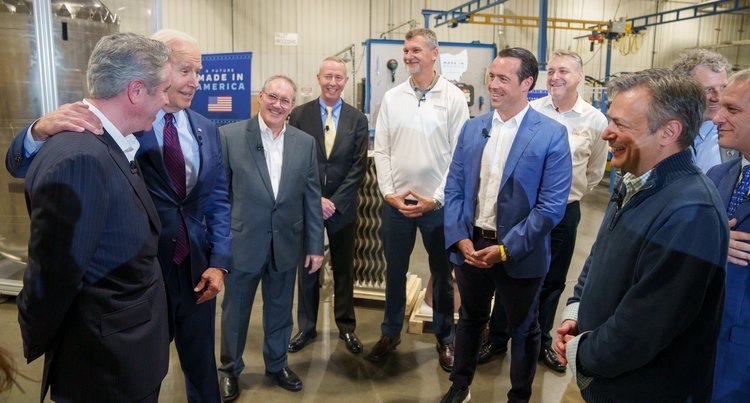$1M to Drive Metal 3D Printing Adoption in ASTRO America Project with GE, Pratt & Whitney, and Honeywell
The Applied Science & Technology Research Organization of America (ASTRO America) has partnered with Pratt & Whitney, Honeywell, and GE on a project intended to ease adoption of metal additive manufacturing (AM) in the US aerospace supply chain. The Office of the Under Secretary of Defense, Research & Engineering awarded ASTRO America $1,000,000 via America Makes, to establish Installation Qualification (IQ) and Operational Qualification (OQ) requirements for in-service metal parts used in aircraft engines.
Called the “Common Additive Manufacturing Qualification Template” project, the purpose is to establish a unified set of parameters that will allow small 3D printing original equipment manufacturers (OEMs) to qualify their production processes via ASTRO America. As parts qualification is one of the lengthiest and most expensive phases of incorporating AM into serial production, streamlining this aspect of the process in particular should make it far easier for 3D printing OEMs to sell their platforms to the US’s leading aerospace manufacturers.
ASTRO America, Honeywell, and GE Additive (part of GE) were all instrumental to the formation of the the Biden administration’s AM Forward initiative in May 2022, while Pratt & Whitney is a subsidiary of RTX, another founding member of AM Forward. Moreover, given ASTRO America’s role in AM Forward Florida—which is serving as a pilot program for the national-level version of the initiative — this project can be seen as a contribution to the genuine establishment of AM Forward as a pillar of the emergent US advanced manufacturing ecosystem.
In a press release about ASTRO America’s partnership with Pratt & Whitney, GE, and Honeywell for America Makes’ (CAM-QT) project, Neal Orringer, the president of ASTRO America, said, “Metal 3D printing is becoming an essential part of manufacturing jet engines. But it’s still very hard to get particular additive machines and materials approved for production. It’s costly and time-consuming for small aerospace suppliers. Ultimately, this can end up keeping good businesses and products out of the supply chain. Now, for the first time, top-tier OEMs are coming together to address this problem and support broader adoption of AM, and ASTRO is thrilled to lead this project and work with GE, Honeywell, Pratt & Whitney, and America Makes — and really make a difference.”

One of the most subtly significant moments of the year for the US AM sector occurred when representatives from ASTRO America, Lockheed Martin, GE, and Stifel Financial met with Deputy Secretary of Defense Kathleen Hicks and head of the US Small Business Administration (SBA), Isabella Casillas Guzman, at the Pentagon on August 1. The main topic of discussion was the possible establishment of a Small Business Investment Fund (SBIF), specifically structured to support AM Forward’s objectives.
While it remains to be seen, whether or not such an SBIF will be created, every action the Biden administration has taken since then concerning advanced manufacturing — and there have been plenty — suggests that it should still be considered very much on the table.
The US AM sector desperately needs that fund, and, even more urgently, so does the US defense industrial base (DIB). This is not solely about quantity of funding, as it is estimated that the DoD, already, will spend $300 million on 3D printers in 2023. Rather, it is about the precise makeup of the money to be spent: business environments in general can’t thrive amid uncertainty, and in the context of defense, the business environment can’t survive at all when uncertainty prevails.
Small and medium manufacturers (SMMs) need to be able to afford the exact platforms required by their customers — in this case, the prime contractors largely comprising the DIB — and those customers need to determine precisely which platforms those are. Organizations like ASTRO America and 3D printing OEMs are doing their part. Now, the federal government and the primes have to finish the job, or the supply chain they’re trying to manage won’t even get off the ground.
Images courtesy of ASTRO America
Subscribe to Our Email Newsletter
Stay up-to-date on all the latest news from the 3D printing industry and receive information and offers from third party vendors.
Print Services
Upload your 3D Models and get them printed quickly and efficiently.
You May Also Like
Bambu Lab Targets the Enterprise Market with New H2D Pro Printer
As we learned from our interview with Cedric Mallet, Bambu Lab had not considered the enterprise and manufacturing market when it launched its first 3D printer. Nonetheless, thousands of businesses...
3D Printing News Briefs, July 31, 2025: Falcon A1 Pro Launch, Kickstarter 3D Printer, & More
Today’s 3D Printing News Briefs is all about new products! We’ll tell you about some new components and machines related to additive, as well as a new 3D printer on...
3D Printing News Briefs, July 19, 2025: Topology Optimization, Bike Saddle, & More
In this weekend’s 3D Printing News Briefs, Farsoon Technologies has reached a milestone of 150 large-format metal 3D printing systems being sold globally. Snapmaker unveiled a new 3D printer, and...
UltiMaker Launches S6 3D Printer for Applications in Education, Defense, & Manufacturing
UltiMaker launched its professional S5 3D printer back in 2018, and since then has also released the S7 and, just a few months ago, the S8. Today, the company continues...





























